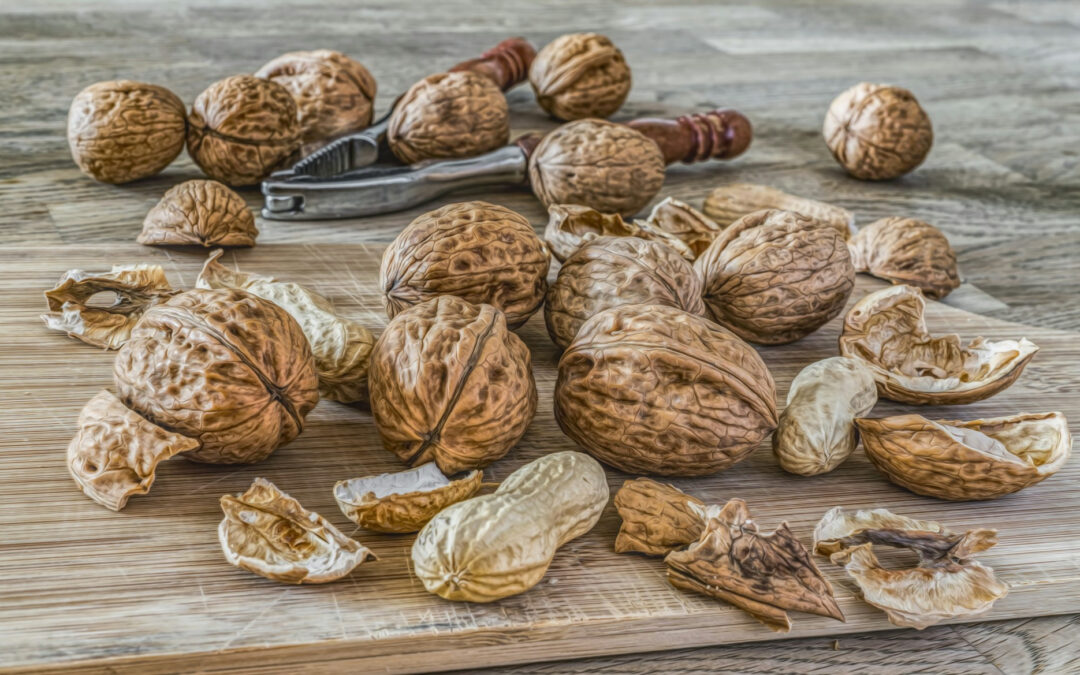Chi non conosce le noci, un concentrato di energia e benessere? Ricche di proprietà benefiche, queste piccole meraviglie della natura sono da sempre apprezzate per il loro gusto inconfondibile e i loro innumerevoli benefici per la salute. Ma sapevi che le noci hanno un passato avvolto nel mistero e nella leggenda? Il loro albero, appartenente alla famiglia delle Juglandaceae, porta con sé un nome che rimanda ai tempi antichi: Jovis Glans, ovvero ghianda di Giove, il re degli dei nell’antica Roma. Un nome che sottolinea l’importanza che questa pianta aveva per le antiche civiltà, considerata un simbolo di sacralità e di connessione con il divino.
Popular beliefs
Ma le leggende legate a questo albero non finiscono qui. Hai mai sentito parlare delle noci come del “frutto delle streghe“? Per secoli, si è creduto che sotto l’ombra di un noce, streghe e stregoni si riunissero per i loro rituali misteriosi, danzando e tessendo incantesimi. Nel Medioevo, il noce era considerato addirittura la dimora del diavolo! Si diceva che chi si fosse addormentato sotto le sue fronde si sarebbe svegliato posseduto da spiriti maligni. E non è tutto: la tradizione popolare attribuiva al noce poteri oscuri, tanto da sconsigliare di dormire alla sua ombra, pena mal di testa, spossatezza e febbre. Ancora oggi, in alcune zone, si evita di costruire stalle vicino ai noci, poiché si crede che le loro radici possano nuocere agli animali.
What does science say about nuts?
La scienza, a quanto pare, ci offre una chiara spiegazione al fenomeno culturale dietro questo frutto. Nelle foglie e nelle radici del noce è presente una sostanza tossica, la juglandina, capace di inibire la crescita di altre piante nelle sue vicinanze. Questo fenomeno, noto come allelopatia, potrebbe aver contribuito a far sì che l’albero di noce fosse visto come un solitario e potente dominatore del suo territorio. È curioso notare come da questo albero sia nato anche l’aggettivo “nocivo”, a testimoniare il timore e il rispetto che l’uomo ha sempre provato nei suoi confronti.
We have seen how juglandin, present in the leaves and roots of walnut trees, is responsible for a phenomenon called allelopathy. But how exactly does this substance affect other plants?
La juglandina, una volta rilasciata nel terreno, viene assorbita dalle radici delle piante vicine, interferendo con i loro processi vitali. In particolare, inibisce la germinazione dei semi, rallenta la crescita delle radici e delle foglie, e può addirittura causare la morte delle piante più sensibili. Questo meccanismo di difesa naturale permette al noce di assicurarsi lo spazio e le risorse necessarie per crescere e svilupparsi.
It is important to emphasise that not all plants are equally susceptible to juglandin. Some species are more resistant and manage to coexist with walnut, while others are strongly inhibited in their growth. Moreover, the concentration of juglandin in the soil varies depending on the environmental conditions and the stage of development of the tree.
The walnut in Greek mythology: a symbol of love and transformation
Anche nella mitologia greca, il noce è avvolto da un alone di mistero e leggende. Uno dei miti più famosi legati a questo albero è quello di Dioniso e Caria. Caria era una delle tre figlie del re della Laconia e, tra le sorelle, era la più bella. Il dio Dioniso, affascinato dalla sua bellezza, se ne innamorò perdutamente. Le altre sorelle, piene di invidia, cercarono in tutti i modi di separare i due innamorati. Per vendicarsi della loro gelosia, Dioniso le trasformò in pietra. Caria, distrutta dal dolore per la sorte delle sorelle e dalla lontananza dal suo amato dio, morì di tristezza.
The walnut tree and the cult of Artemis
La storia di Caria e Dioniso non si conclude qui. Si narra che, in seguito a questi tragici eventi, Dioniso trasformò Caria in un bellissimo noce. Questo mito stabilisce un legame profondo tra l’albero di noce e il mondo femminile. Infatti, il noce era spesso associato anche alla dea Artemide, dea della caccia e della Luna, simbolo di indipendenza e forza femminile. In alcune regioni della Grecia, si venerava addirittura Artemide Cariatide, e i templi a lei dedicati erano adornati con colonne a forma di figure femminili scolpite nel legno di noce. Questo legame tra il noce e il mondo femminile sottolinea la duplice natura di questo albero, simbolo sia di amore e passione che di dolore e trasformazione.
Walnuts: a treasure trove of legends and benefits
Ma non tutte le leggende legate alle noci sono negative. Anzi, in molte culture, questo frutto è considerato un simbolo di buona fortuna e prosperità. Si dice che sognare le noci sia un presagio positivo, annunciando l’arrivo di sorprese piacevoli. Inoltre, in numerose fiabe e leggende, le noci sono spesso raffigurate come preziosi scrigni che custodiscono tesori inestimabili, simboleggiando la ricchezza interiore e le potenzialità nascoste.
A talisman against the evil eye
Le noci sono state utilizzate per secoli come amuleti protettivi contro il malocchio e le energie negative. Nel sud Italia, in particolare, era usanza portare con sé una noce per allontanare le malattie e le sfortune. Questo profondo legame tra le noci e la protezione ha radici antiche e si ritrova in diverse culture. Inoltre, la forma sferica della noce, simile a quella del cervello, ha portato molti a credere che questo frutto avesse proprietà benefiche per la mente.
Discover the world of nuts
Ora che hai scoperto le affascinanti leggende e i significati simbolici legati alle noci, non potrai più guardare a questo frutto con gli stessi occhi. Le noci sono molto più di un semplice alimento: sono un ponte tra passato e presente, un simbolo di cultura e tradizione. E se vuoi scoprire una vasta gamma di noci e altri frutti secchi, non esitare a visitare il nostro sito web al seguente link: Naturalia shop.





